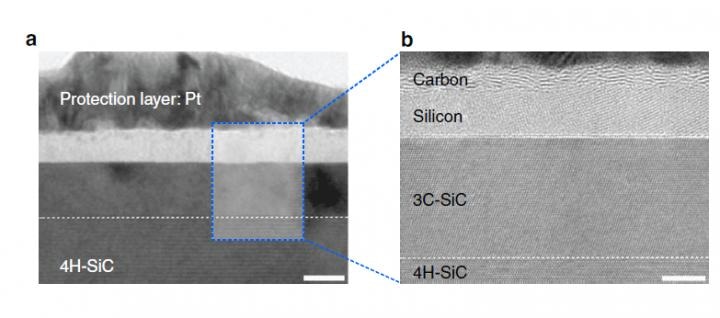Dec 2 2016
 High-resolution transmission electron microscopy shows that after just one laser pulse of 30 nanoseconds, the silicon carbide (SiC) substrate is melted and separates into a carbon and a silicon layer. More pulses cause the carbon layer to organize into graphene and the silicon to leave as gas. (Credit – IBS)
High-resolution transmission electron microscopy shows that after just one laser pulse of 30 nanoseconds, the silicon carbide (SiC) substrate is melted and separates into a carbon and a silicon layer. More pulses cause the carbon layer to organize into graphene and the silicon to leave as gas. (Credit – IBS)
All smartphones are designed with shiny flat AMOLED displays. A minimum of two silicon transistors, which were manufactured in large scale using laser annealing technologies, hide behind each pixel of these displays.
While the traditional techniques to manufacture them use temperatures over 1,000 °C, the laser technique achieves the same results at low temperatures even on plastic substrates (melting temperature lower than 300 °C). A fascinating discovery is that a similar technique can be applied to produce graphene crystals. Graphene is a thin and strong nano-material composed of carbon, and its heat-conductive and electric properties have drawn the attention of researchers around the world.
Graphene synthesis mechanism using laser-induced solid-state phase separation of single-crystal silicon carbide (SiC) was discovered by Prof. Keon Jae Lee's research group at the Center for Multidimensional Carbon Materials within the Institute for Basic Science (IBS) and Prof. Choi Sung-Yool's team at KAIST.
The research findings have been published in Nature Communications. The paper explains how this laser technology can divide a complex compound (SiC) into its ultrathin elements of silicon and carbon.
Although many fundamental studies understood the effect of excimer lasers in changing elemental materials such as silicon, the laser interaction with advanced complex compounds like SiC has hardly ever been studied because of the ultra-short processing time and complexity of compound phase transition.
Using molecular dynamic simulations and high resolution microscope images, the researchers discovered that a single-pulse irradiation of xenon chloride excimer laser of 30 nanoseconds melts SiC, causing the separation of a liquid SiC layer, a disordered carbon layer with graphitic domains (approximately 2.5 nm thick) on top surface and a polycrystalline silicon layer (roughly 5 nm) below carbon layer.
The sublimation of the separated silicon is caused when additional pulses are given while the disordered carbon layer is changed into a multilayer graphene.
This research shows that the laser material interaction technology can be a powerful tool for next generation of two dimensional nanomaterials.
Professor Keon Jeo Lee, IBS
Prof. Choi added: "Using laser-induced phase separation of complex compounds, new types of two dimensional materials can be synthesized in the future."
IBS Prof. Keon is affiliated with the School of Materials Science and Engineering, KAIST and Prof. Choi with the School of Electrical Engineering and Graphene Research Center, KAIST.